Evaluating the Strategic Importance of M&A in Today's Corporate World
VerifiedAdded on 2020/10/22
|7
|1993
|69
Essay
AI Summary
The essay provides an overview of the growth in mergers and acquisitions (M&A) over recent years, illustrating their role as essential tools for corporate growth and expansion. By acquiring or merging with other entities, businesses can access new markets, diversify products, and achieve economies of scale, thereby gaining a competitive edge. This trend is fueled by increased consumer demand across various regions, pushing companies to expand rapidly through inorganic growth methods. The essay also highlights the challenges associated with M&A, such as integration issues and management efficiency, underscoring the need for strategic planning to harness long-term benefits. Overall, M&A activities are portrayed as vital strategies for businesses aiming to thrive in a dynamic global market.
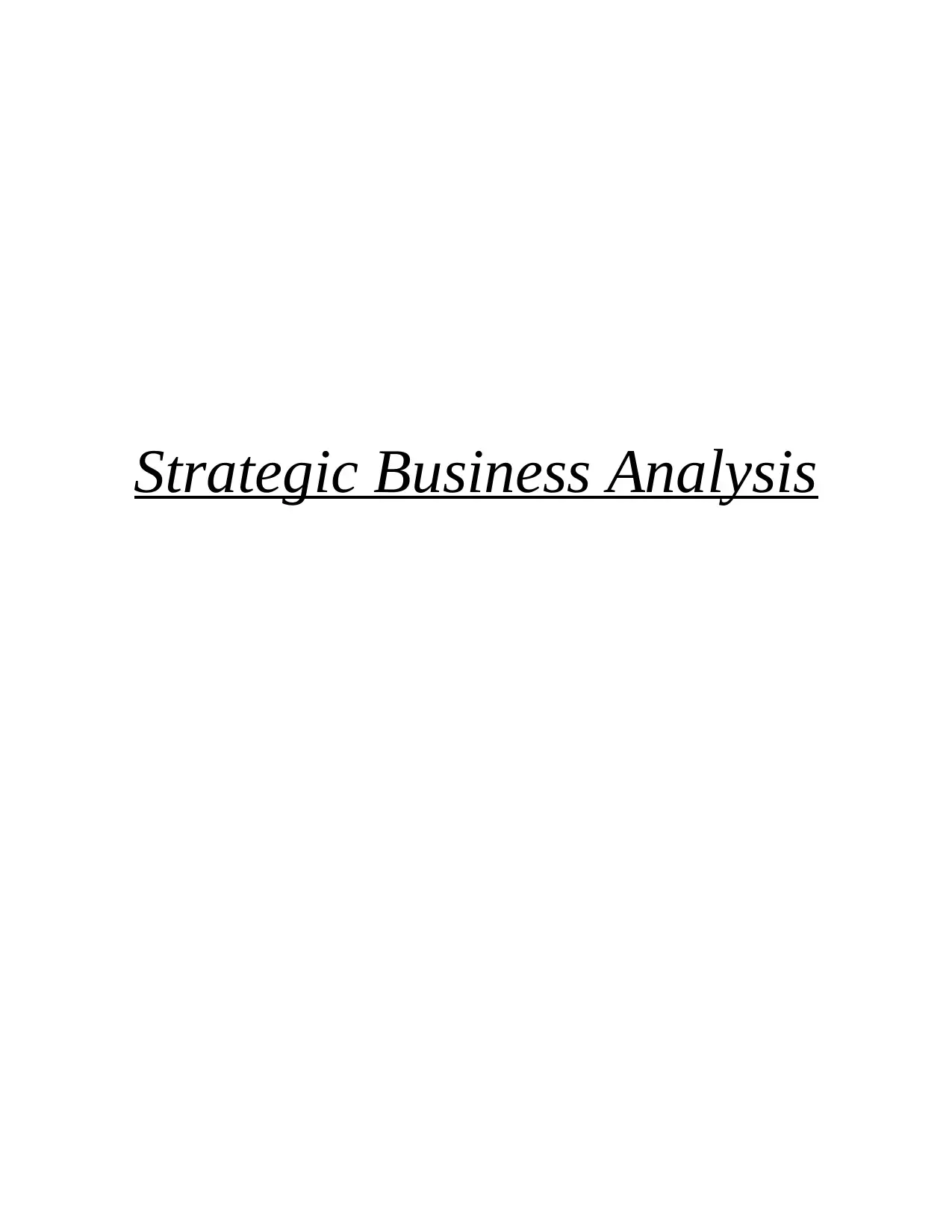
Strategic Business Analysis
Paraphrase This Document
Need a fresh take? Get an instant paraphrase of this document with our AI Paraphraser

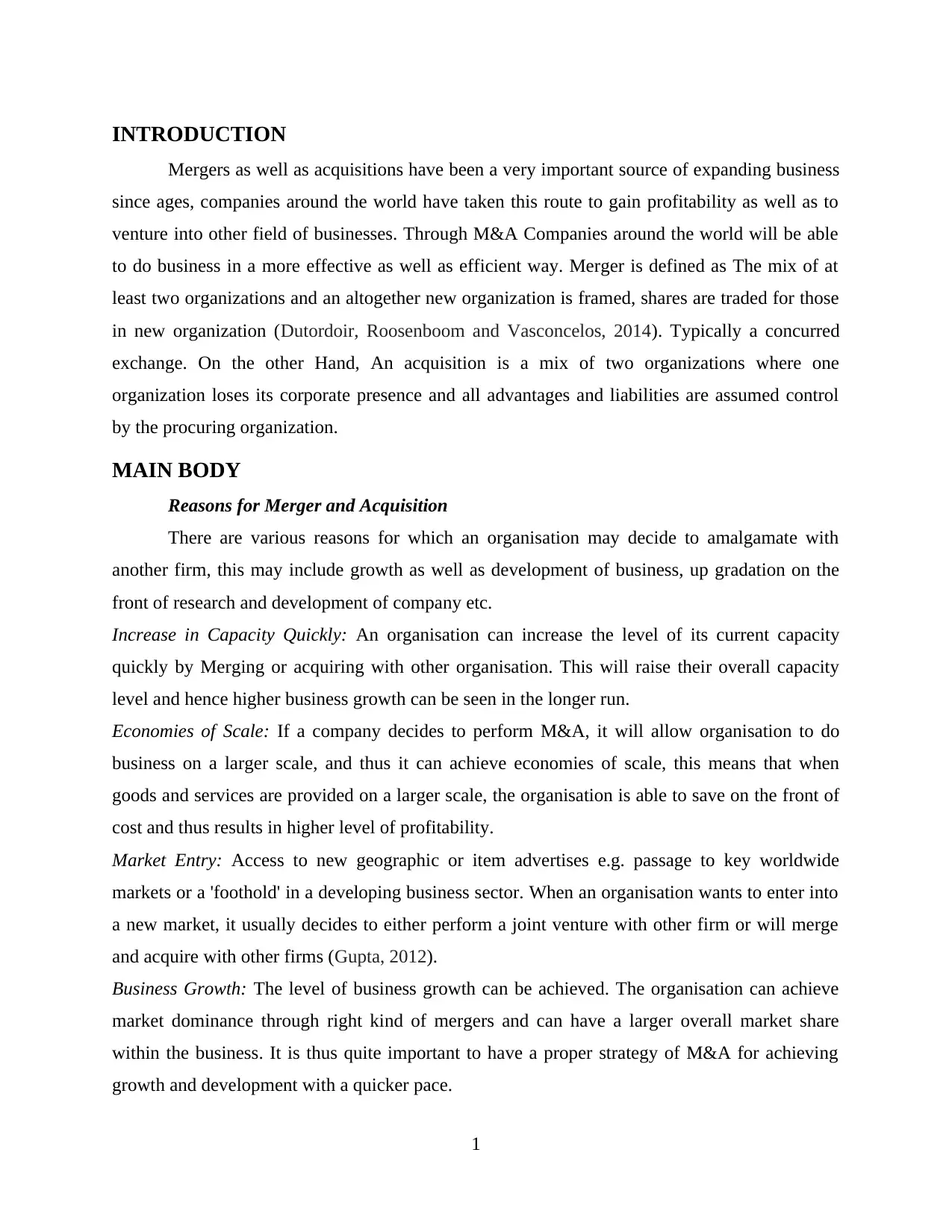
INTRODUCTION
Mergers as well as acquisitions have been a very important source of expanding business
since ages, companies around the world have taken this route to gain profitability as well as to
venture into other field of businesses. Through M&A Companies around the world will be able
to do business in a more effective as well as efficient way. Merger is defined as The mix of at
least two organizations and an altogether new organization is framed, shares are traded for those
in new organization (Dutordoir, Roosenboom and Vasconcelos, 2014). Typically a concurred
exchange. On the other Hand, An acquisition is a mix of two organizations where one
organization loses its corporate presence and all advantages and liabilities are assumed control
by the procuring organization.
MAIN BODY
Reasons for Merger and Acquisition
There are various reasons for which an organisation may decide to amalgamate with
another firm, this may include growth as well as development of business, up gradation on the
front of research and development of company etc.
Increase in Capacity Quickly: An organisation can increase the level of its current capacity
quickly by Merging or acquiring with other organisation. This will raise their overall capacity
level and hence higher business growth can be seen in the longer run.
Economies of Scale: If a company decides to perform M&A, it will allow organisation to do
business on a larger scale, and thus it can achieve economies of scale, this means that when
goods and services are provided on a larger scale, the organisation is able to save on the front of
cost and thus results in higher level of profitability.
Market Entry: Access to new geographic or item advertises e.g. passage to key worldwide
markets or a 'foothold' in a developing business sector. When an organisation wants to enter into
a new market, it usually decides to either perform a joint venture with other firm or will merge
and acquire with other firms (Gupta, 2012).
Business Growth: The level of business growth can be achieved. The organisation can achieve
market dominance through right kind of mergers and can have a larger overall market share
within the business. It is thus quite important to have a proper strategy of M&A for achieving
growth and development with a quicker pace.
1
Mergers as well as acquisitions have been a very important source of expanding business
since ages, companies around the world have taken this route to gain profitability as well as to
venture into other field of businesses. Through M&A Companies around the world will be able
to do business in a more effective as well as efficient way. Merger is defined as The mix of at
least two organizations and an altogether new organization is framed, shares are traded for those
in new organization (Dutordoir, Roosenboom and Vasconcelos, 2014). Typically a concurred
exchange. On the other Hand, An acquisition is a mix of two organizations where one
organization loses its corporate presence and all advantages and liabilities are assumed control
by the procuring organization.
MAIN BODY
Reasons for Merger and Acquisition
There are various reasons for which an organisation may decide to amalgamate with
another firm, this may include growth as well as development of business, up gradation on the
front of research and development of company etc.
Increase in Capacity Quickly: An organisation can increase the level of its current capacity
quickly by Merging or acquiring with other organisation. This will raise their overall capacity
level and hence higher business growth can be seen in the longer run.
Economies of Scale: If a company decides to perform M&A, it will allow organisation to do
business on a larger scale, and thus it can achieve economies of scale, this means that when
goods and services are provided on a larger scale, the organisation is able to save on the front of
cost and thus results in higher level of profitability.
Market Entry: Access to new geographic or item advertises e.g. passage to key worldwide
markets or a 'foothold' in a developing business sector. When an organisation wants to enter into
a new market, it usually decides to either perform a joint venture with other firm or will merge
and acquire with other firms (Gupta, 2012).
Business Growth: The level of business growth can be achieved. The organisation can achieve
market dominance through right kind of mergers and can have a larger overall market share
within the business. It is thus quite important to have a proper strategy of M&A for achieving
growth and development with a quicker pace.
1
⊘ This is a preview!⊘
Do you want full access?
Subscribe today to unlock all pages.

Trusted by 1+ million students worldwide
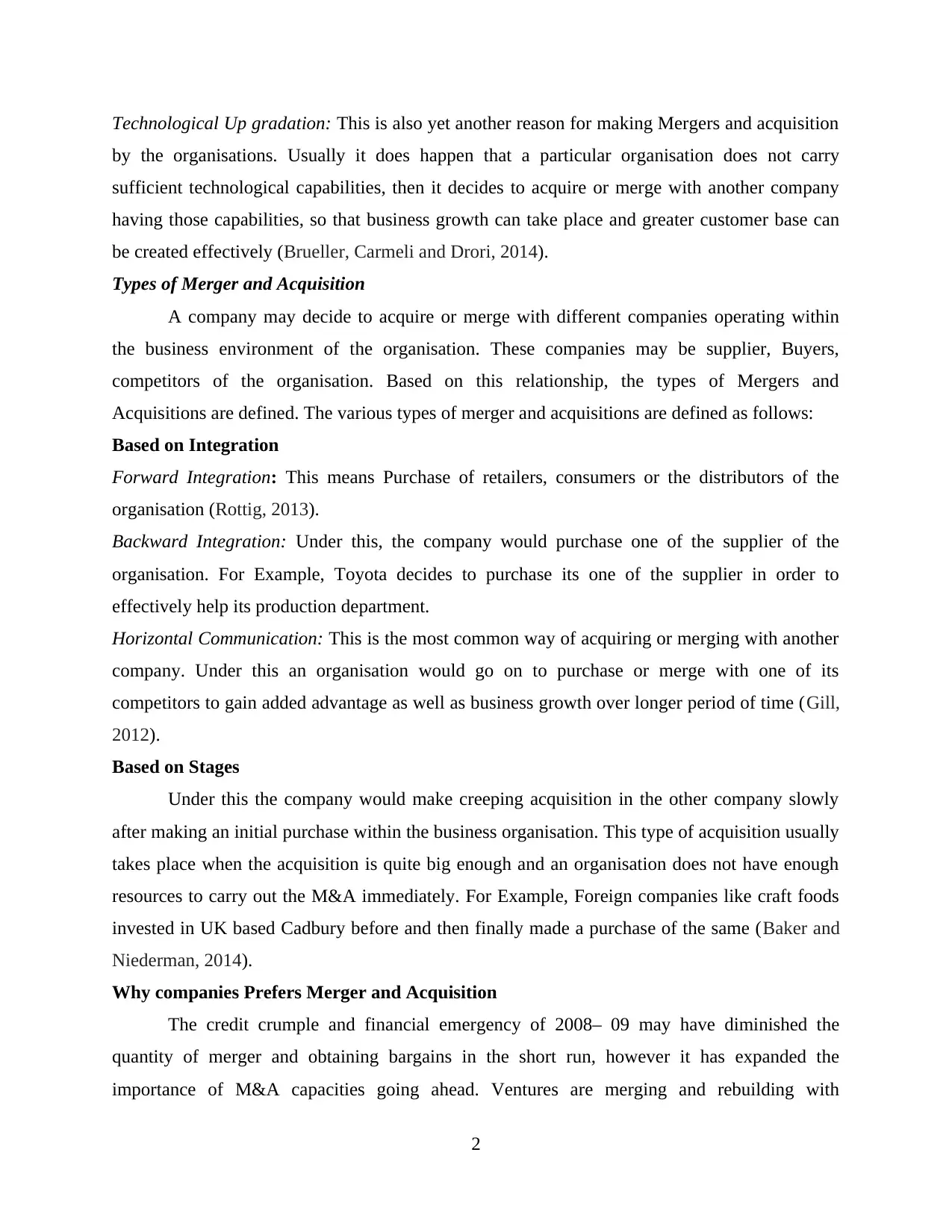
Technological Up gradation: This is also yet another reason for making Mergers and acquisition
by the organisations. Usually it does happen that a particular organisation does not carry
sufficient technological capabilities, then it decides to acquire or merge with another company
having those capabilities, so that business growth can take place and greater customer base can
be created effectively (Brueller, Carmeli and Drori, 2014).
Types of Merger and Acquisition
A company may decide to acquire or merge with different companies operating within
the business environment of the organisation. These companies may be supplier, Buyers,
competitors of the organisation. Based on this relationship, the types of Mergers and
Acquisitions are defined. The various types of merger and acquisitions are defined as follows:
Based on Integration
Forward Integration: This means Purchase of retailers, consumers or the distributors of the
organisation (Rottig, 2013).
Backward Integration: Under this, the company would purchase one of the supplier of the
organisation. For Example, Toyota decides to purchase its one of the supplier in order to
effectively help its production department.
Horizontal Communication: This is the most common way of acquiring or merging with another
company. Under this an organisation would go on to purchase or merge with one of its
competitors to gain added advantage as well as business growth over longer period of time (Gill,
2012).
Based on Stages
Under this the company would make creeping acquisition in the other company slowly
after making an initial purchase within the business organisation. This type of acquisition usually
takes place when the acquisition is quite big enough and an organisation does not have enough
resources to carry out the M&A immediately. For Example, Foreign companies like craft foods
invested in UK based Cadbury before and then finally made a purchase of the same (Baker and
Niederman, 2014).
Why companies Prefers Merger and Acquisition
The credit crumple and financial emergency of 2008– 09 may have diminished the
quantity of merger and obtaining bargains in the short run, however it has expanded the
importance of M&A capacities going ahead. Ventures are merging and rebuilding with
2
by the organisations. Usually it does happen that a particular organisation does not carry
sufficient technological capabilities, then it decides to acquire or merge with another company
having those capabilities, so that business growth can take place and greater customer base can
be created effectively (Brueller, Carmeli and Drori, 2014).
Types of Merger and Acquisition
A company may decide to acquire or merge with different companies operating within
the business environment of the organisation. These companies may be supplier, Buyers,
competitors of the organisation. Based on this relationship, the types of Mergers and
Acquisitions are defined. The various types of merger and acquisitions are defined as follows:
Based on Integration
Forward Integration: This means Purchase of retailers, consumers or the distributors of the
organisation (Rottig, 2013).
Backward Integration: Under this, the company would purchase one of the supplier of the
organisation. For Example, Toyota decides to purchase its one of the supplier in order to
effectively help its production department.
Horizontal Communication: This is the most common way of acquiring or merging with another
company. Under this an organisation would go on to purchase or merge with one of its
competitors to gain added advantage as well as business growth over longer period of time (Gill,
2012).
Based on Stages
Under this the company would make creeping acquisition in the other company slowly
after making an initial purchase within the business organisation. This type of acquisition usually
takes place when the acquisition is quite big enough and an organisation does not have enough
resources to carry out the M&A immediately. For Example, Foreign companies like craft foods
invested in UK based Cadbury before and then finally made a purchase of the same (Baker and
Niederman, 2014).
Why companies Prefers Merger and Acquisition
The credit crumple and financial emergency of 2008– 09 may have diminished the
quantity of merger and obtaining bargains in the short run, however it has expanded the
importance of M&A capacities going ahead. Ventures are merging and rebuilding with
2
Paraphrase This Document
Need a fresh take? Get an instant paraphrase of this document with our AI Paraphraser

expanding speed now and then by decision, and at times by force of government. Organizations
with accessible money are seeking after an expanding exhibit of obtaining openings introduced
to them as the emergency unfolds markets or a 'foothold' in a developing business sector
(Krishnakumar and Sethi, 2012). Most of the companies finds it suitable to conduct business by
acquiring other companies and hence leading to rapid growth and development in the current
business and managers of the businesses around the world finds it suitable to grow business
through inorganic growth instead of organic growth. Organic basically means achieving business
growth through selling of goods as well as services in an effective manner, it does not include
growth through purchasing business of others and then the resources of the acquired company
will be claimed as ow resources and hence a higher business growth can be seen through this and
investors can be made satisfied through this by showing them a bigger picture.
The organizations that ace the capacities of fruitful M&A and assemble their groups in
like manner are the most liable to prevail in the unverifiable, hyperactive M&A condition of the
coming years. At the point when a M&A group is gifted and able, a specific force grabs hold.
The frameworks and procedures, administration, and lines of business begin acting in
arrangement. Physical areas close down as arranged; a few people are reassigned, others are
advanced; business accomplices are picked; IT systems are connected or eliminated; impetus
structures are consolidated; and societies are fit. At last, the two organizations wind up one. The
procedure of the procurement is finished, and the new organization turns its consideration,
indeed, to the prospects of developments (Goddard, Molyneux and Zhou, 2012).
There seem, by all accounts, to be three for the most part acknowledged classifications of
merger thought processes. To begin with, mergers may be embraced to upgrade the monetary
execution of the firm. Economic thought processes incorporate expanding professional fits,
accomplishing economies of scale, hazard spreading, cost decreases, getting a 'deal' because of
market valuation differentials, taking a guarded position, or reacting to showcase
disappointments. Second, mergers may happen in light of the fact that chiefs see an individual
advantage. These individual thought processes incorporate expanded esteem through expanded
deals and firm development, or expanded compensation through expanded deals or productivity.
Furthermore, the administrative test exhibited by coordinating another firm and administering the
tasks of a bigger firm may likewise add to the individual thought processes of merger exercises.
Third, key thought processes for example, cooperative energy, worldwide extension, seeking
3
with accessible money are seeking after an expanding exhibit of obtaining openings introduced
to them as the emergency unfolds markets or a 'foothold' in a developing business sector
(Krishnakumar and Sethi, 2012). Most of the companies finds it suitable to conduct business by
acquiring other companies and hence leading to rapid growth and development in the current
business and managers of the businesses around the world finds it suitable to grow business
through inorganic growth instead of organic growth. Organic basically means achieving business
growth through selling of goods as well as services in an effective manner, it does not include
growth through purchasing business of others and then the resources of the acquired company
will be claimed as ow resources and hence a higher business growth can be seen through this and
investors can be made satisfied through this by showing them a bigger picture.
The organizations that ace the capacities of fruitful M&A and assemble their groups in
like manner are the most liable to prevail in the unverifiable, hyperactive M&A condition of the
coming years. At the point when a M&A group is gifted and able, a specific force grabs hold.
The frameworks and procedures, administration, and lines of business begin acting in
arrangement. Physical areas close down as arranged; a few people are reassigned, others are
advanced; business accomplices are picked; IT systems are connected or eliminated; impetus
structures are consolidated; and societies are fit. At last, the two organizations wind up one. The
procedure of the procurement is finished, and the new organization turns its consideration,
indeed, to the prospects of developments (Goddard, Molyneux and Zhou, 2012).
There seem, by all accounts, to be three for the most part acknowledged classifications of
merger thought processes. To begin with, mergers may be embraced to upgrade the monetary
execution of the firm. Economic thought processes incorporate expanding professional fits,
accomplishing economies of scale, hazard spreading, cost decreases, getting a 'deal' because of
market valuation differentials, taking a guarded position, or reacting to showcase
disappointments. Second, mergers may happen in light of the fact that chiefs see an individual
advantage. These individual thought processes incorporate expanded esteem through expanded
deals and firm development, or expanded compensation through expanded deals or productivity.
Furthermore, the administrative test exhibited by coordinating another firm and administering the
tasks of a bigger firm may likewise add to the individual thought processes of merger exercises.
Third, key thought processes for example, cooperative energy, worldwide extension, seeking
3
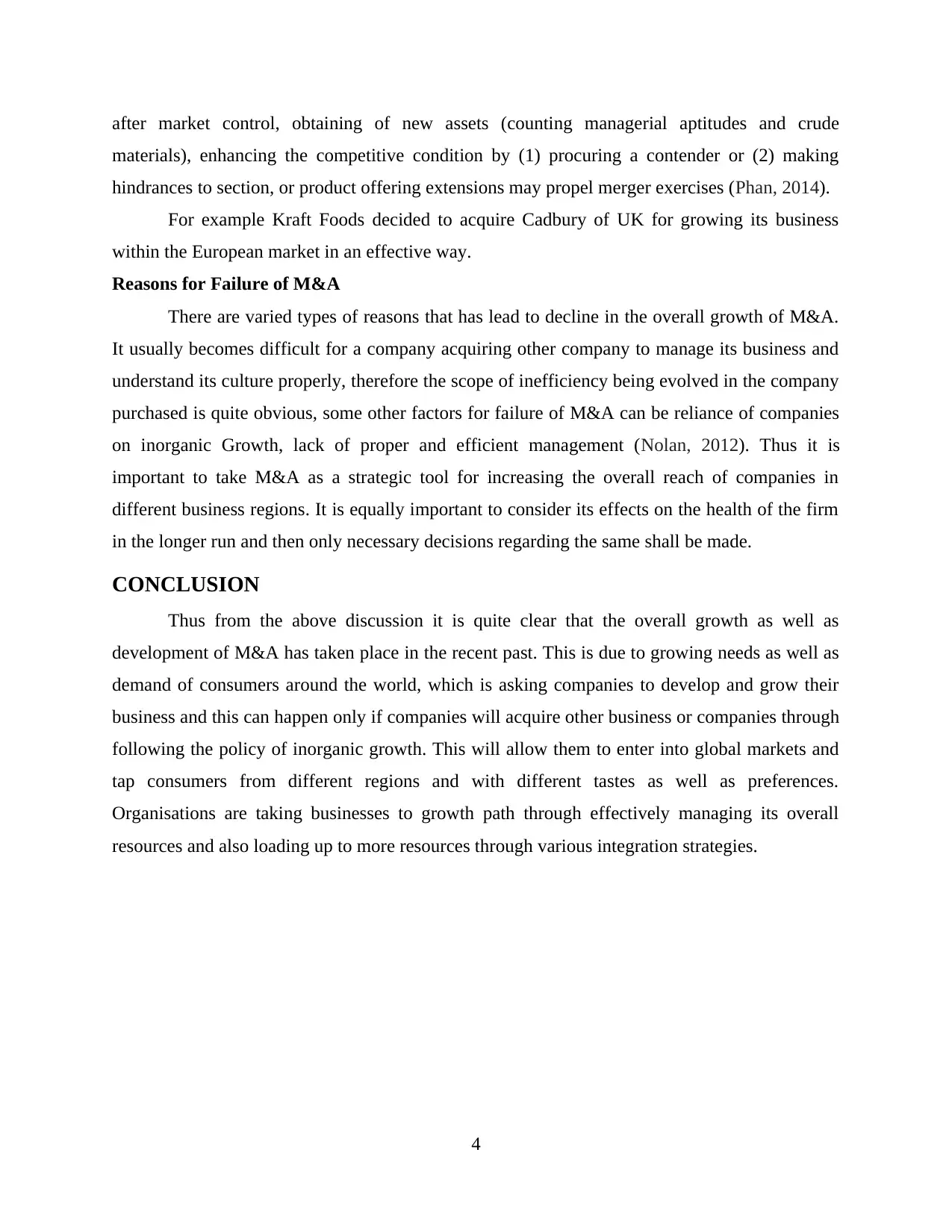
after market control, obtaining of new assets (counting managerial aptitudes and crude
materials), enhancing the competitive condition by (1) procuring a contender or (2) making
hindrances to section, or product offering extensions may propel merger exercises (Phan, 2014).
For example Kraft Foods decided to acquire Cadbury of UK for growing its business
within the European market in an effective way.
Reasons for Failure of M&A
There are varied types of reasons that has lead to decline in the overall growth of M&A.
It usually becomes difficult for a company acquiring other company to manage its business and
understand its culture properly, therefore the scope of inefficiency being evolved in the company
purchased is quite obvious, some other factors for failure of M&A can be reliance of companies
on inorganic Growth, lack of proper and efficient management (Nolan, 2012). Thus it is
important to take M&A as a strategic tool for increasing the overall reach of companies in
different business regions. It is equally important to consider its effects on the health of the firm
in the longer run and then only necessary decisions regarding the same shall be made.
CONCLUSION
Thus from the above discussion it is quite clear that the overall growth as well as
development of M&A has taken place in the recent past. This is due to growing needs as well as
demand of consumers around the world, which is asking companies to develop and grow their
business and this can happen only if companies will acquire other business or companies through
following the policy of inorganic growth. This will allow them to enter into global markets and
tap consumers from different regions and with different tastes as well as preferences.
Organisations are taking businesses to growth path through effectively managing its overall
resources and also loading up to more resources through various integration strategies.
4
materials), enhancing the competitive condition by (1) procuring a contender or (2) making
hindrances to section, or product offering extensions may propel merger exercises (Phan, 2014).
For example Kraft Foods decided to acquire Cadbury of UK for growing its business
within the European market in an effective way.
Reasons for Failure of M&A
There are varied types of reasons that has lead to decline in the overall growth of M&A.
It usually becomes difficult for a company acquiring other company to manage its business and
understand its culture properly, therefore the scope of inefficiency being evolved in the company
purchased is quite obvious, some other factors for failure of M&A can be reliance of companies
on inorganic Growth, lack of proper and efficient management (Nolan, 2012). Thus it is
important to take M&A as a strategic tool for increasing the overall reach of companies in
different business regions. It is equally important to consider its effects on the health of the firm
in the longer run and then only necessary decisions regarding the same shall be made.
CONCLUSION
Thus from the above discussion it is quite clear that the overall growth as well as
development of M&A has taken place in the recent past. This is due to growing needs as well as
demand of consumers around the world, which is asking companies to develop and grow their
business and this can happen only if companies will acquire other business or companies through
following the policy of inorganic growth. This will allow them to enter into global markets and
tap consumers from different regions and with different tastes as well as preferences.
Organisations are taking businesses to growth path through effectively managing its overall
resources and also loading up to more resources through various integration strategies.
4
⊘ This is a preview!⊘
Do you want full access?
Subscribe today to unlock all pages.

Trusted by 1+ million students worldwide
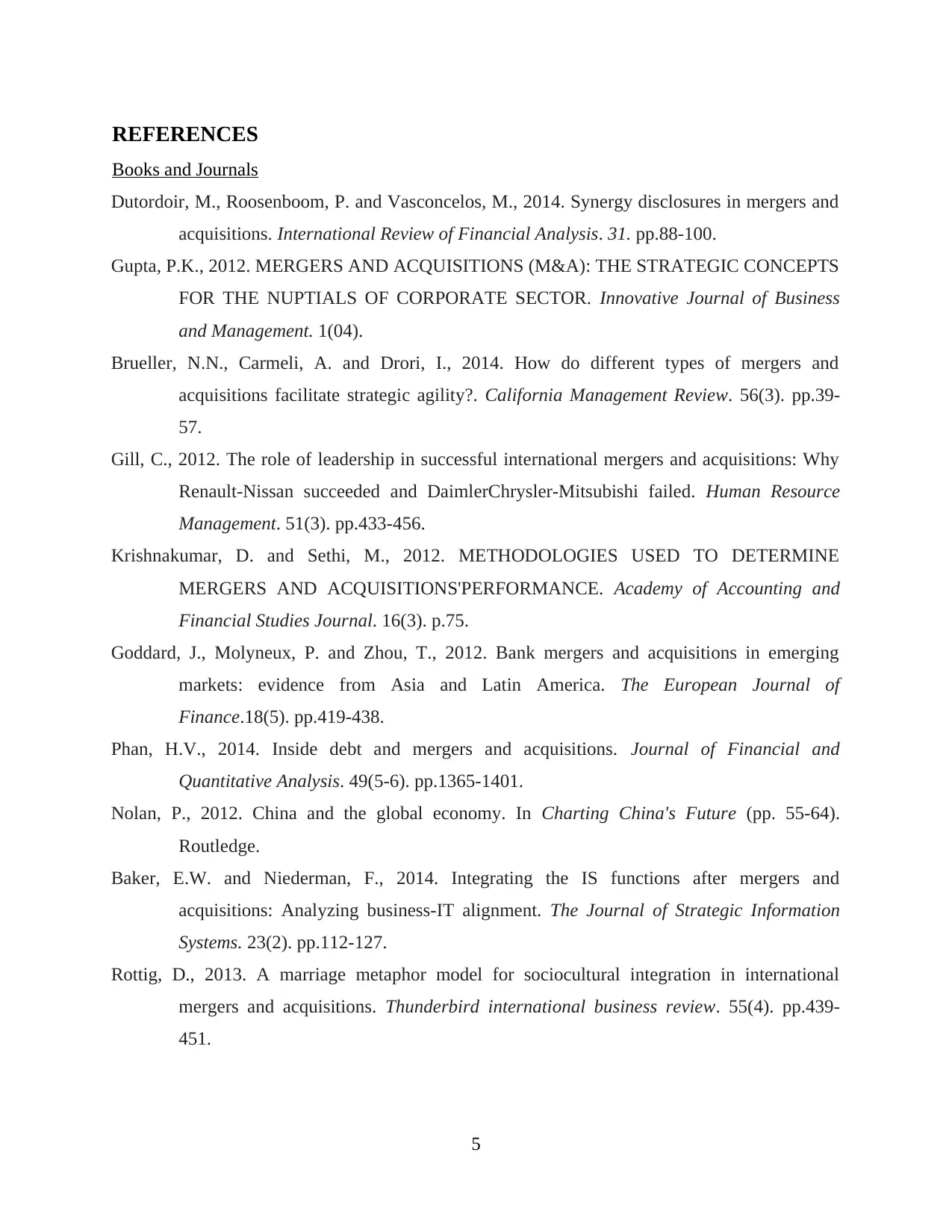
REFERENCES
Books and Journals
Dutordoir, M., Roosenboom, P. and Vasconcelos, M., 2014. Synergy disclosures in mergers and
acquisitions. International Review of Financial Analysis. 31. pp.88-100.
Gupta, P.K., 2012. MERGERS AND ACQUISITIONS (M&A): THE STRATEGIC CONCEPTS
FOR THE NUPTIALS OF CORPORATE SECTOR. Innovative Journal of Business
and Management. 1(04).
Brueller, N.N., Carmeli, A. and Drori, I., 2014. How do different types of mergers and
acquisitions facilitate strategic agility?. California Management Review. 56(3). pp.39-
57.
Gill, C., 2012. The role of leadership in successful international mergers and acquisitions: Why
Renault‐Nissan succeeded and DaimlerChrysler‐Mitsubishi failed. Human Resource
Management. 51(3). pp.433-456.
Krishnakumar, D. and Sethi, M., 2012. METHODOLOGIES USED TO DETERMINE
MERGERS AND ACQUISITIONS'PERFORMANCE. Academy of Accounting and
Financial Studies Journal. 16(3). p.75.
Goddard, J., Molyneux, P. and Zhou, T., 2012. Bank mergers and acquisitions in emerging
markets: evidence from Asia and Latin America. The European Journal of
Finance.18(5). pp.419-438.
Phan, H.V., 2014. Inside debt and mergers and acquisitions. Journal of Financial and
Quantitative Analysis. 49(5-6). pp.1365-1401.
Nolan, P., 2012. China and the global economy. In Charting China's Future (pp. 55-64).
Routledge.
Baker, E.W. and Niederman, F., 2014. Integrating the IS functions after mergers and
acquisitions: Analyzing business-IT alignment. The Journal of Strategic Information
Systems. 23(2). pp.112-127.
Rottig, D., 2013. A marriage metaphor model for sociocultural integration in international
mergers and acquisitions. Thunderbird international business review. 55(4). pp.439-
451.
5
Books and Journals
Dutordoir, M., Roosenboom, P. and Vasconcelos, M., 2014. Synergy disclosures in mergers and
acquisitions. International Review of Financial Analysis. 31. pp.88-100.
Gupta, P.K., 2012. MERGERS AND ACQUISITIONS (M&A): THE STRATEGIC CONCEPTS
FOR THE NUPTIALS OF CORPORATE SECTOR. Innovative Journal of Business
and Management. 1(04).
Brueller, N.N., Carmeli, A. and Drori, I., 2014. How do different types of mergers and
acquisitions facilitate strategic agility?. California Management Review. 56(3). pp.39-
57.
Gill, C., 2012. The role of leadership in successful international mergers and acquisitions: Why
Renault‐Nissan succeeded and DaimlerChrysler‐Mitsubishi failed. Human Resource
Management. 51(3). pp.433-456.
Krishnakumar, D. and Sethi, M., 2012. METHODOLOGIES USED TO DETERMINE
MERGERS AND ACQUISITIONS'PERFORMANCE. Academy of Accounting and
Financial Studies Journal. 16(3). p.75.
Goddard, J., Molyneux, P. and Zhou, T., 2012. Bank mergers and acquisitions in emerging
markets: evidence from Asia and Latin America. The European Journal of
Finance.18(5). pp.419-438.
Phan, H.V., 2014. Inside debt and mergers and acquisitions. Journal of Financial and
Quantitative Analysis. 49(5-6). pp.1365-1401.
Nolan, P., 2012. China and the global economy. In Charting China's Future (pp. 55-64).
Routledge.
Baker, E.W. and Niederman, F., 2014. Integrating the IS functions after mergers and
acquisitions: Analyzing business-IT alignment. The Journal of Strategic Information
Systems. 23(2). pp.112-127.
Rottig, D., 2013. A marriage metaphor model for sociocultural integration in international
mergers and acquisitions. Thunderbird international business review. 55(4). pp.439-
451.
5
1 out of 7
Related Documents
Your All-in-One AI-Powered Toolkit for Academic Success.
+13062052269
info@desklib.com
Available 24*7 on WhatsApp / Email
![[object Object]](/_next/static/media/star-bottom.7253800d.svg)
Unlock your academic potential
Copyright © 2020–2025 A2Z Services. All Rights Reserved. Developed and managed by ZUCOL.





